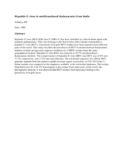| dc.contributor.author | Acharya, KS | |
| dc.date.accessioned | 2013-07-08T12:53:17Z | |
| dc.date.available | 2013-07-08T12:53:17Z | |
| dc.date.issued | 1988 | |
| dc.identifier.citation | KIRTDA, DRACHARYAS. 1988. Hepatitis G virus in multitransfused thalassaemics from India. J Gastroenterol Hepatol. 1998 Sep;13(9):902-6 | en |
| dc.identifier.uri | http://profiles.uonbi.ac.ke/sacharya/publications/hepatitis-g-virus-multitransfused-thalassaemics-india-j-gastroenterol-hepatol- | |
| dc.identifier.uri | http://erepository.uonbi.ac.ke:8080/xmlui/handle/123456789/46513 | |
| dc.description.abstract | Hepatitis G virus (HGV)/GB virus-C (GBV-C) has been identified as a blood-borne agent with disputed pathogenicity. This virus belongs to the flaviviridae with a distant relationship to hepatitis C virus (HCV). Genetically divergent HGV isolates have been reported from different parts of the world. This study describes the prevalence of HGV in multitransfused thalassaemic children in India and genomic sequence variations in 11 HGV isolates from the same geographical location. Hepatitis G virus RNA was detected in 39.7% multitransfused thalassaemic children. The seroprevalence of hepatitis B virus (HBV) and HCV was 23.8% and 17.1%, respectively, and 11.4% had dual infection. The nucleotide sequence of a 166 bp HGV genomic segment from the putative capsid-envelope region (nucleotide; nt 578-743) from 11 Indian isolates was compared to the sequences available in the nucleotide databases. The isolates from India were 81.3-94.5% homologous to the isolates from other parts of the world. On phylogenetic analysis, it was observed that HGV isolates from India may belong to two genetically divergent types. | en |
| dc.language.iso | en | en |
| dc.title | Hepatitis G virus in multitransfused thalassaemics from India | en |
| dc.type | Article | en |
| local.publisher | Department of Medicine, College of Health Sciences, University of Nairobi | en |

